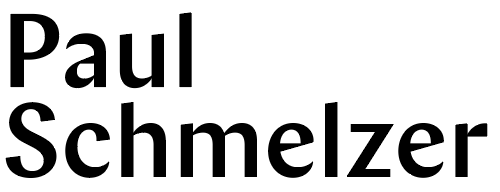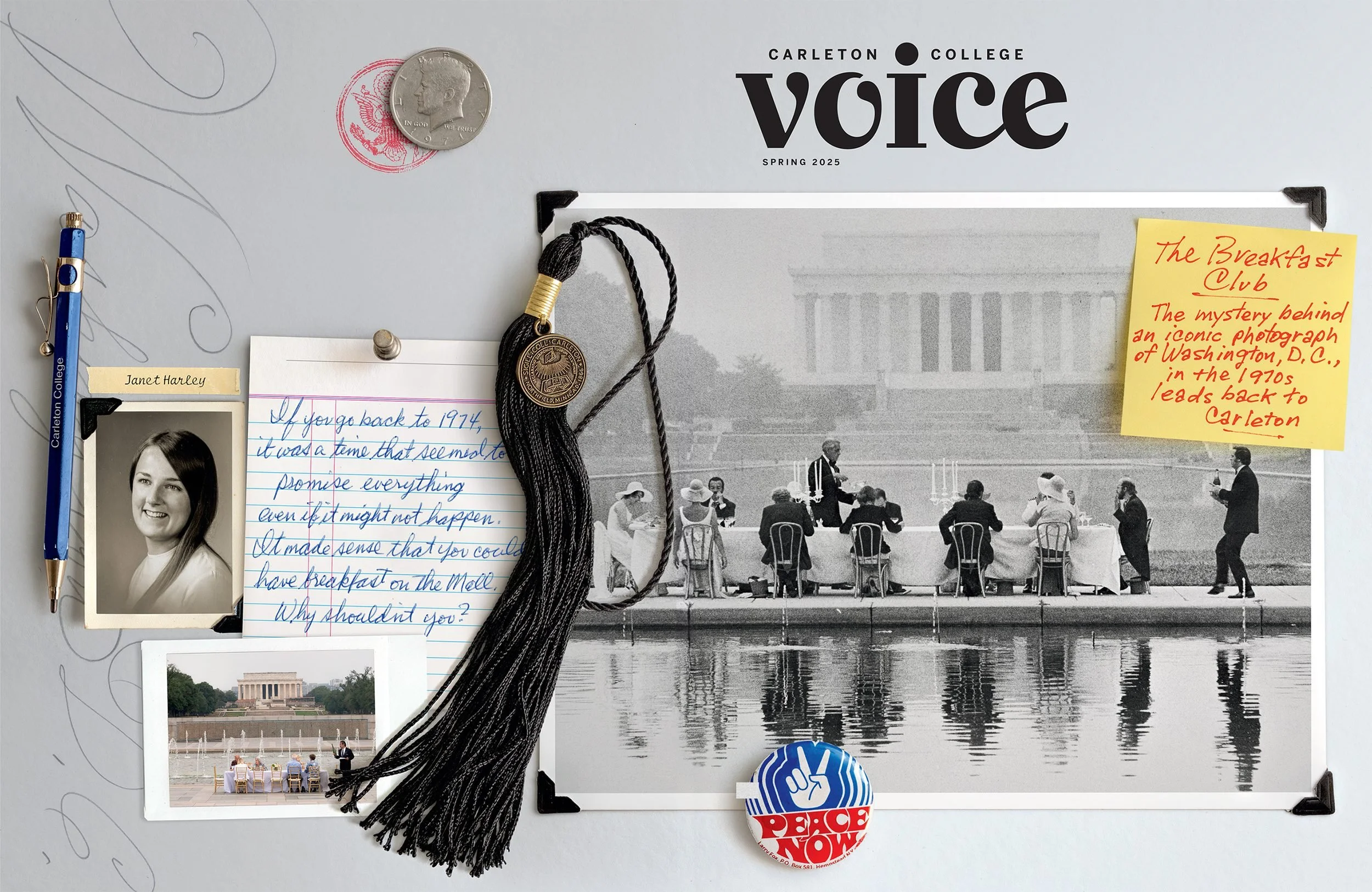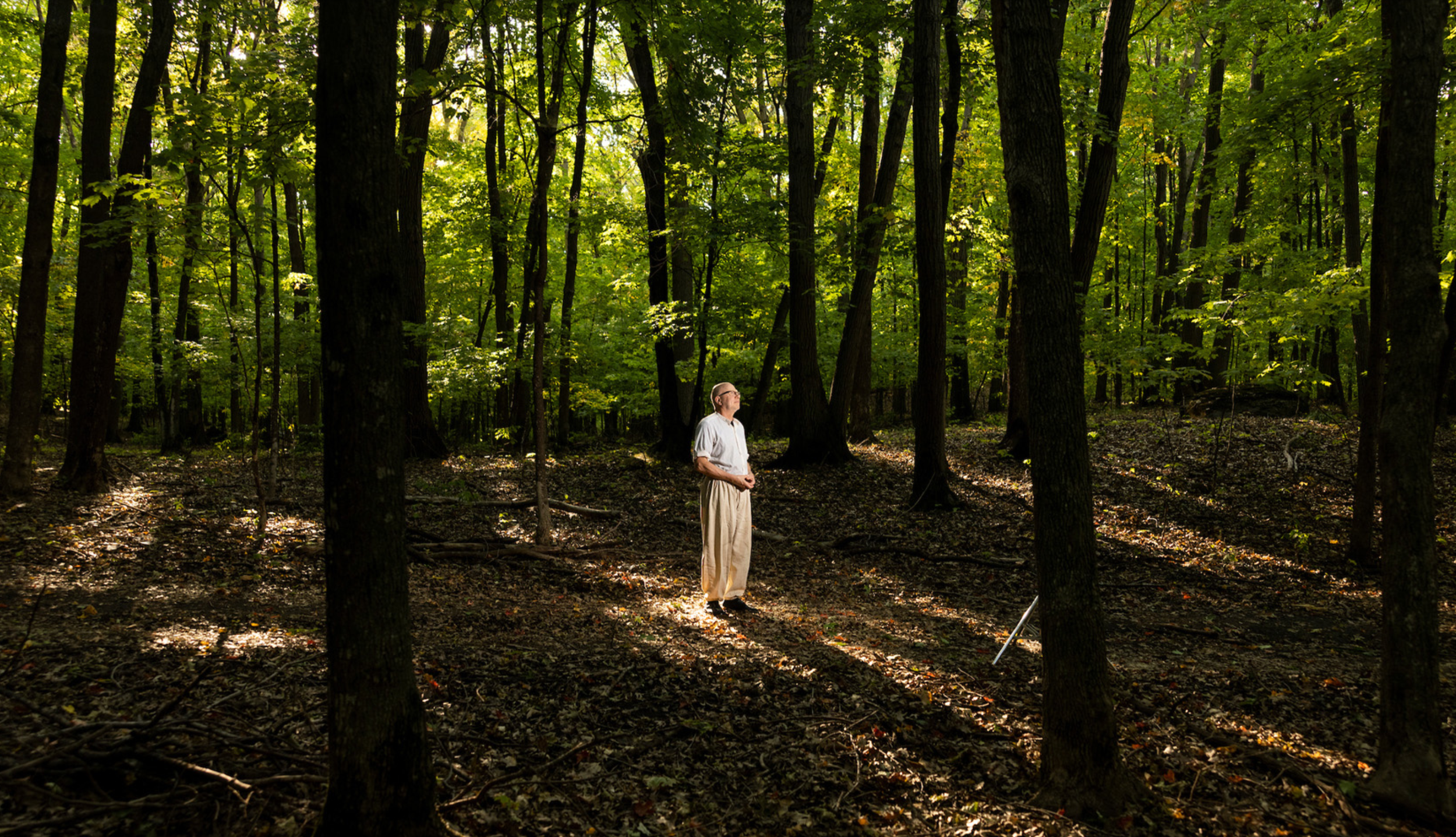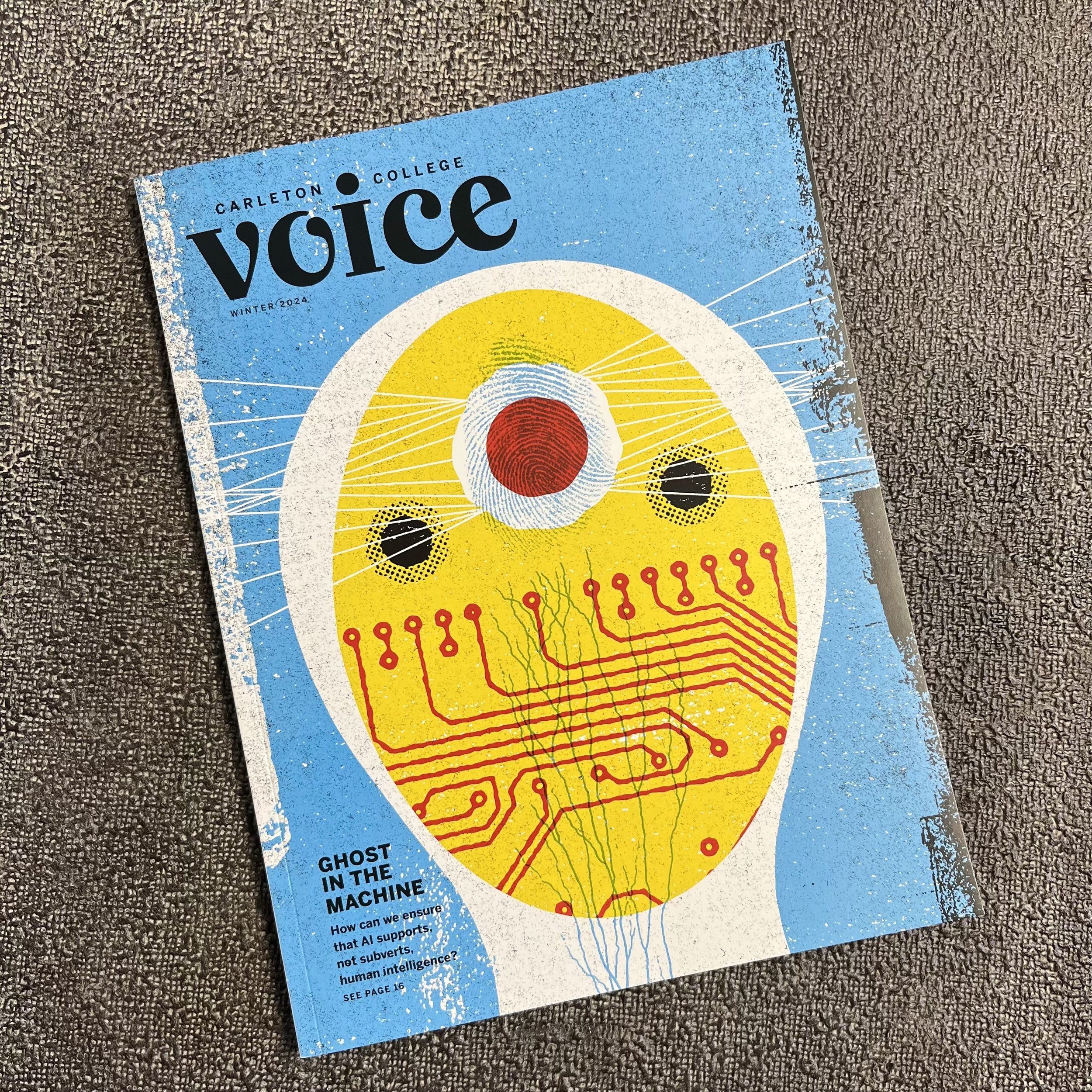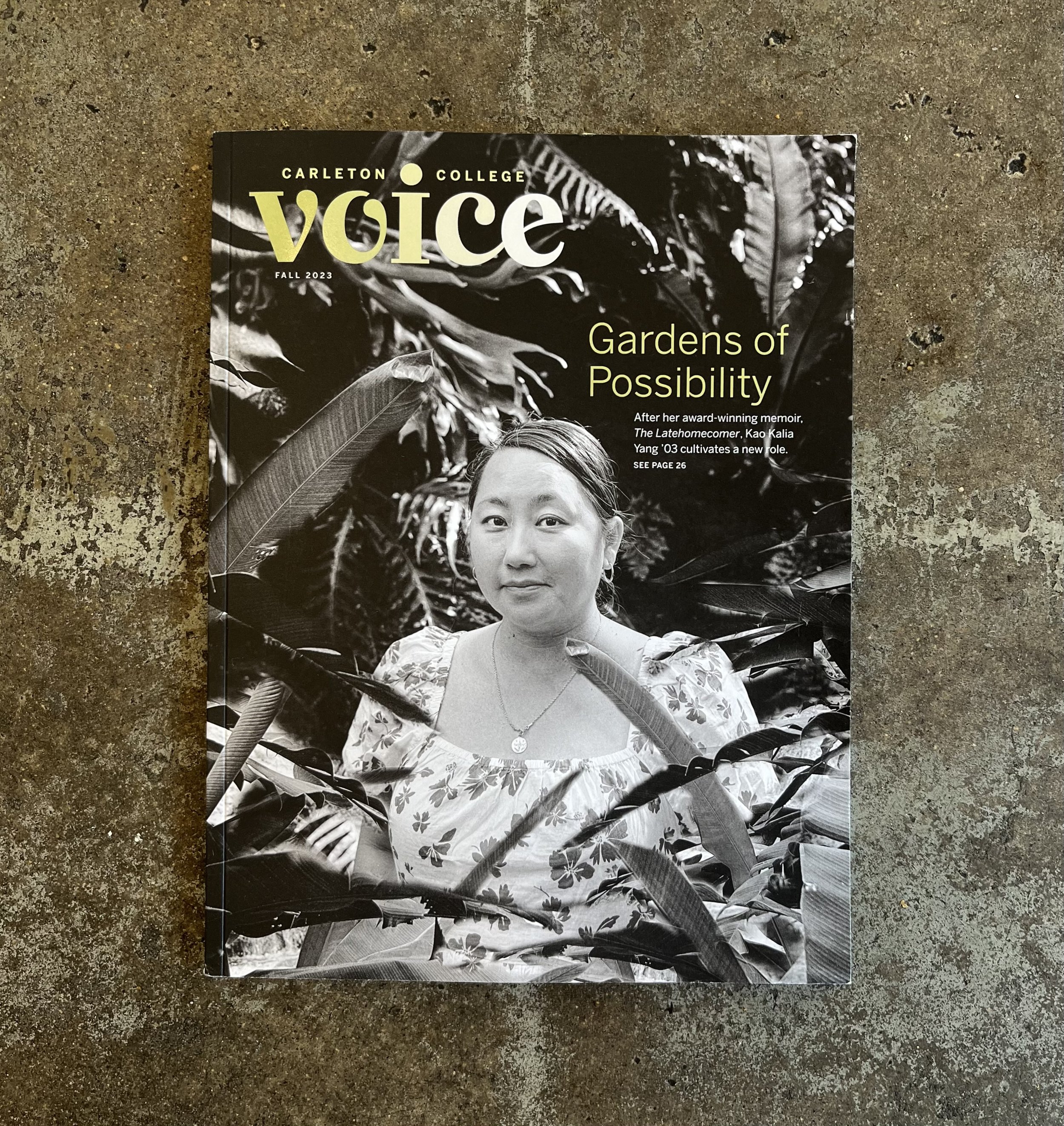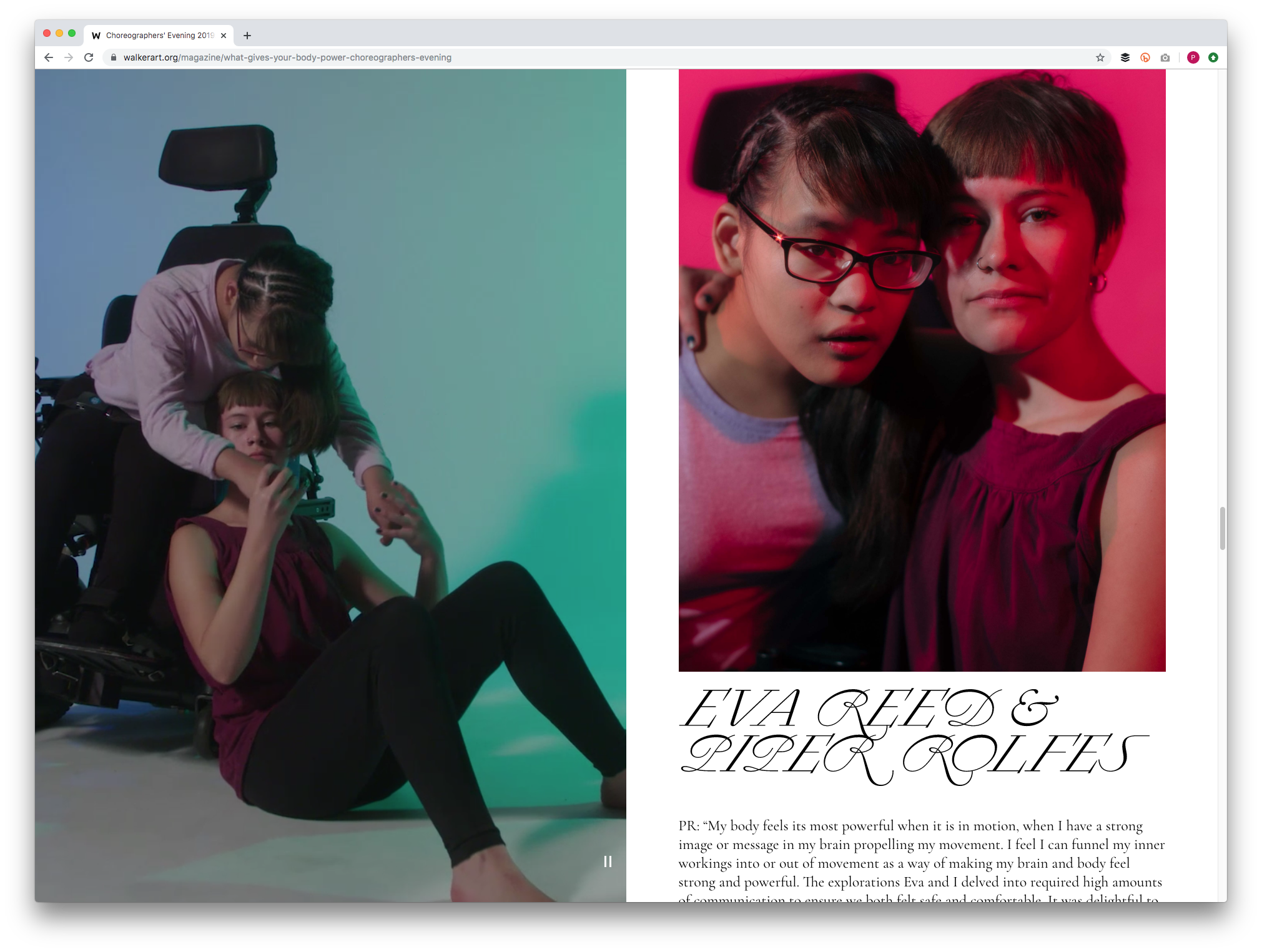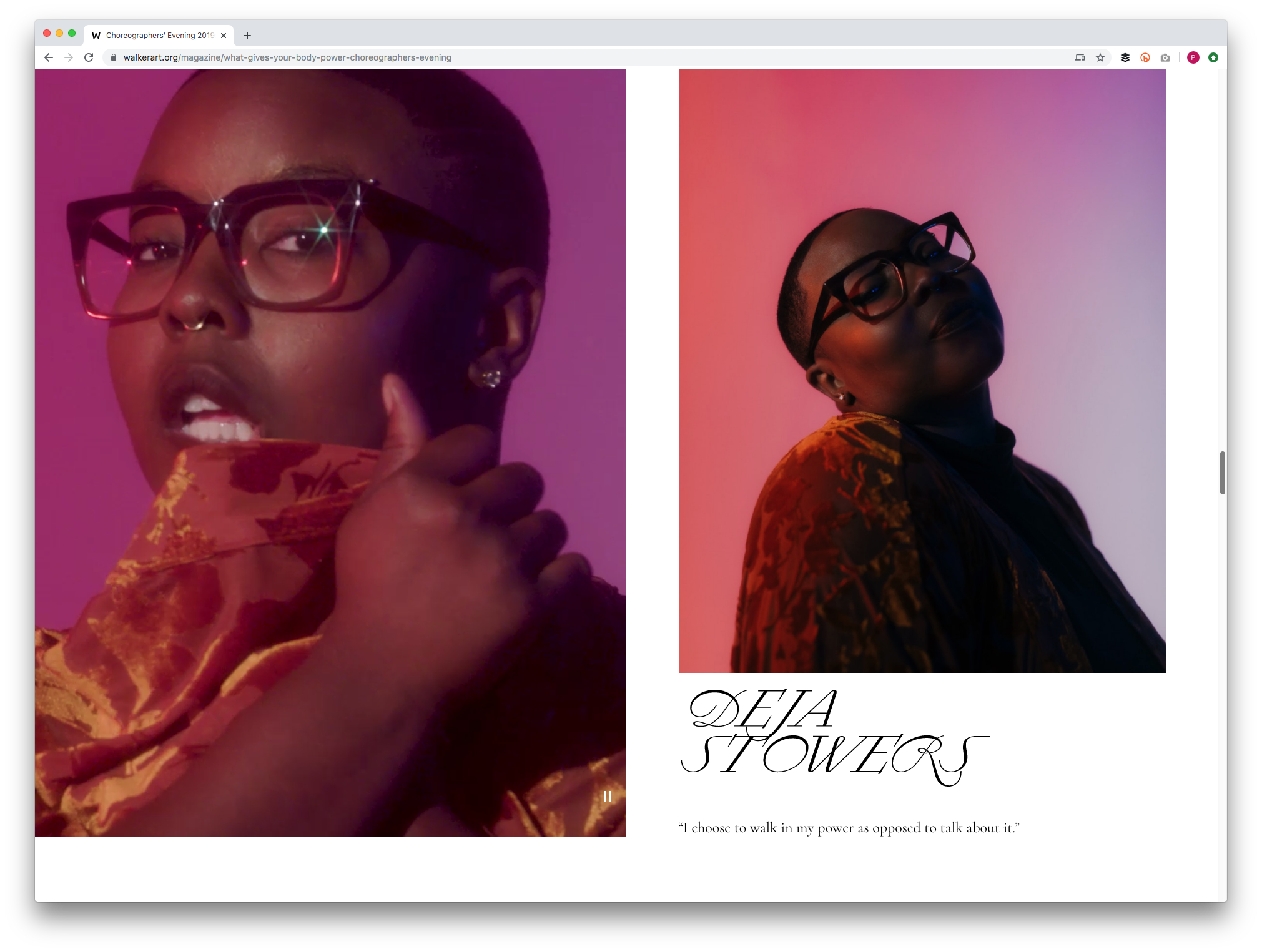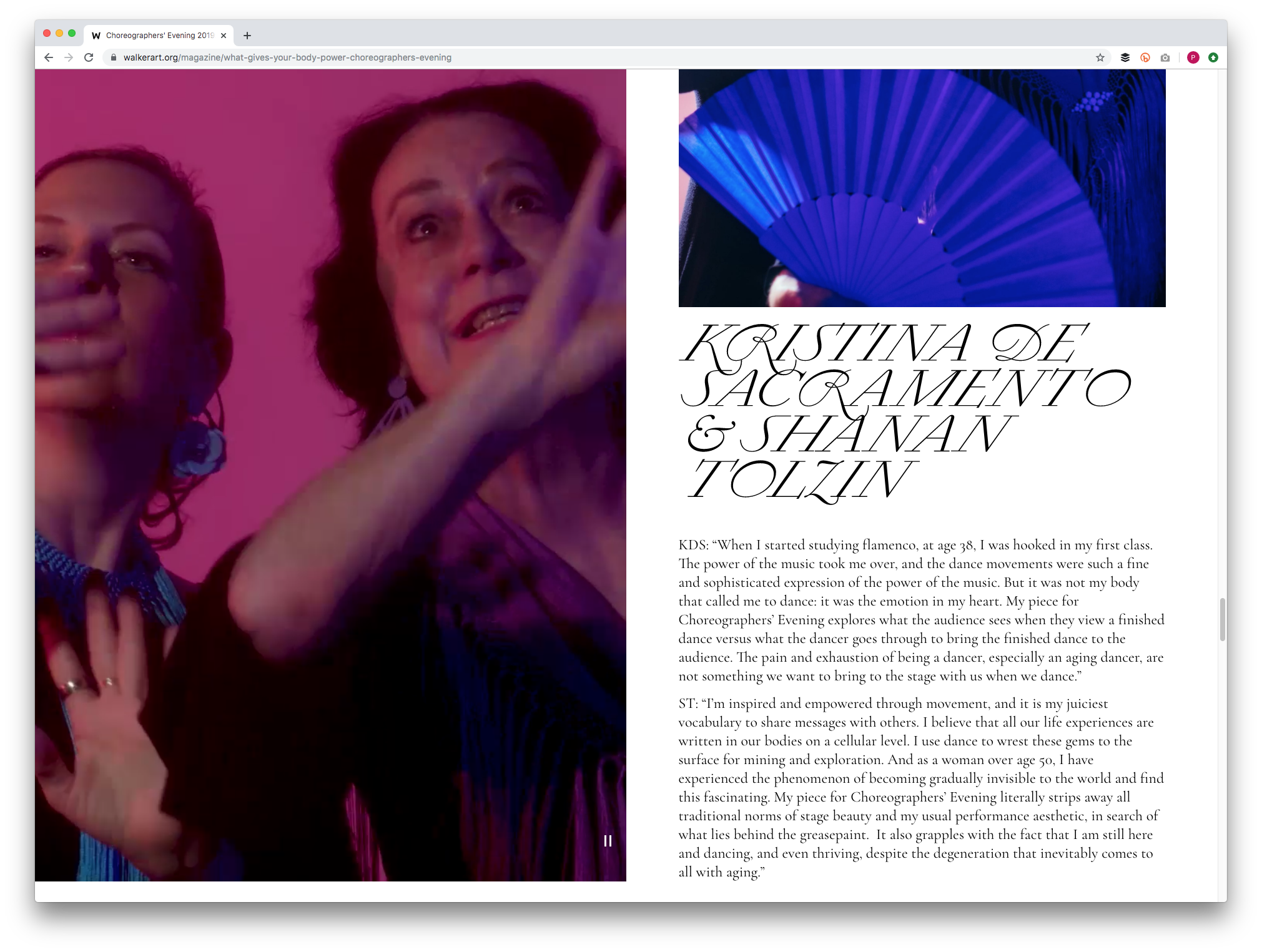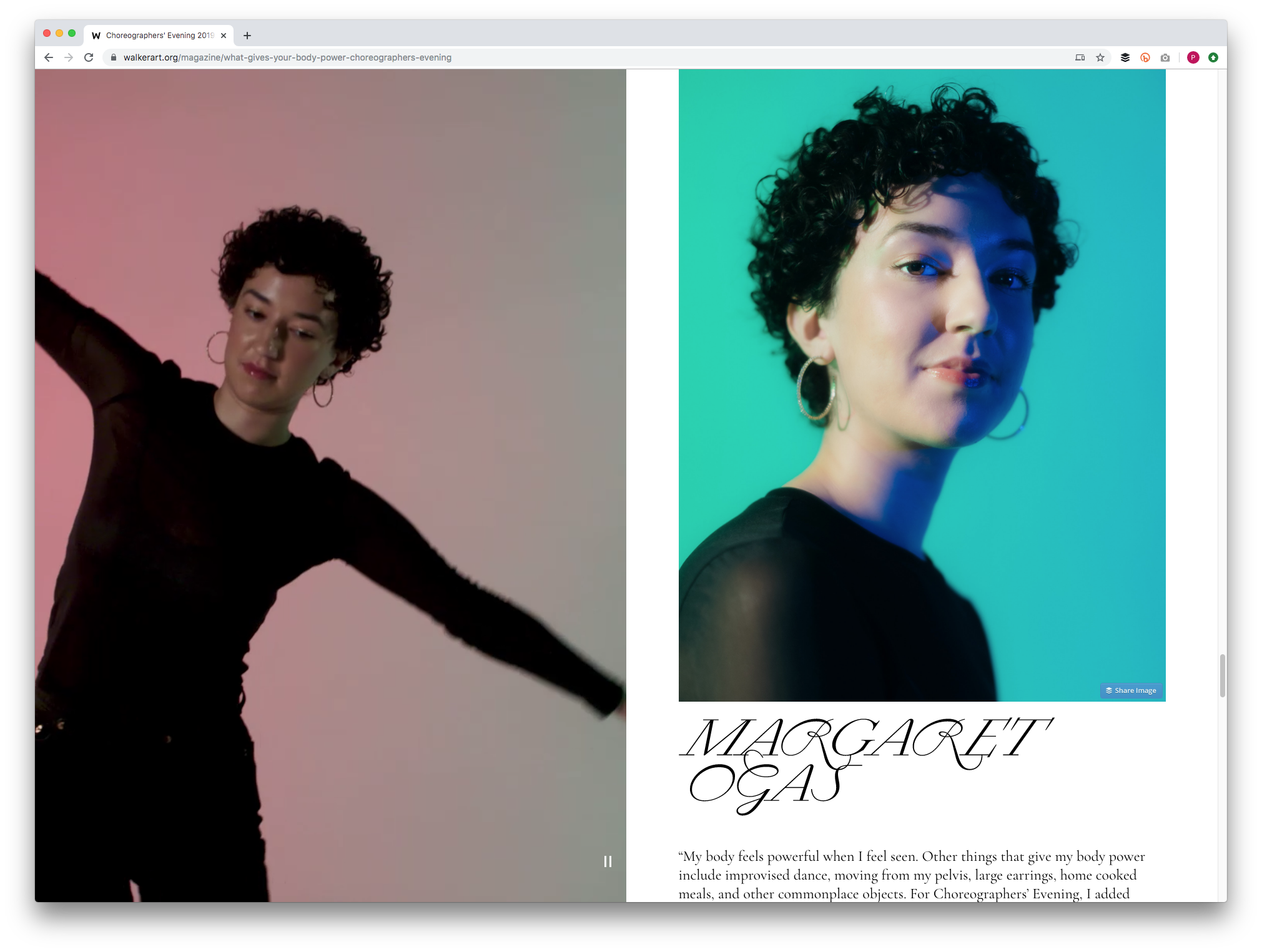The new issue is one of my favorites, thanks to two incredible anchor pieces. Former Minnesota Monthly editor returns to deliver a powerful story. Long before pop-ups and flash mobs, an unusual sight met visitors to the National Mall on the morning of July 19, 1974: a formal breakfast in view of the Lincoln Memorial, complete with horse-drawn carriage, a string quartet, and candelabra. Captured by a photographer for The Washington Post, the image has since become one of the paper's best-selling prints. Tim Gihring shares the poignant story of recent Carleton College graduates, all drawn to DC to serve their country, pulling off an audacious surprise for a beloved classmate. The piece was animated by artist Jack Molloy, who created tableaux for the front and back covers and story spreads using keepsakes shared by alumni. Another return: multiple James Beard Prize–winning culinary writer heads back to campus to revisit her college cafeteria in a poignant (and hilarious) remembrance. And: Carleton’s Curious Collections, a look at career pivots, and some “real talk about small business.”
Carleton Voice wins a CASE silver award
June marked my second anniversary at Carleton College, and my first time entering the CASE Awards, the global nonprofit association promoting higher ed. I’m pleased to note that the Carleton College Voice took home a silver Circle of Excellence award from the Council for Advancement and Support of Education for our three 2024 issues.
From the judges:
Carleton College Voice was one of our favorites. The design was excellent and the graphic elements stood out. We felt these pieces 'really broke away from the public relations machine' and told stories that were bold, fun, and in some cases truly brave, and even sometimes risky—but oh so important. The writing was sharp, excellent, and often laugh-out-loud funny. A good read rendered beautifully.
Seven higher-ed institutions received awards in the category for colleges and universities publishing three or more times a year, with Holy Cross taking gold, Wake Forest also taking silver, and bronzes going to Boston University, the University of Pittsburgh, Bowdoin, and Kenyon.
From West to East: New rural series launches at the National Gallery of Art
As guest editor of the Midwest region of the just-published National Gallery of Art series “West to East,” I invited three rural writers to share their perspectives on how place shapes creativity—and contributed a writing of my own.
Called Back: On George Morrison, Land Acknowledgement, and Returning Home
Artist Andrea Carlson writes about the art of George Morrison and her return to Gichi Bitobig (Grand Marais), a landscape that influenced Morrison deeply. A member of the Grand Portage Band of Lake Superior Chippewa, she parses what’s left out when we see didactic labels for Morrison’s art that leave out so much of the story.
An aerial view of Francis Xavier Church, the Chippewa City church George Morrison and his family attended. Photo: Jenn Ackerman and Tim Gruber
Modernist Barns and Modern Farmers
Owner of Pied Beauty Farm and associate professor of English at the University of Wisconsin – Whitewater, Joshua Mabie looks at the ways artists like Grant Wood leveraged agrarian symbolism, unwittingly obscuring the reality of life for rural people. Fun fact: while the house in Wood’s American Gothic remains a tourist destination in Iowa, the red barn over the couple’s shoulder never existed: “[It] is a figment of Wood’s imagination, added to confirm the painting’s rural setting.”
Iowa Artists Craft Complex Visions of the Rural
Matthew Fluharty, executive director of Art of the Rural, focuses on Grant Wood’s immersive Corn Room murals as a way to “understand how land, tradition, and personal experience have motivated rural, regional artists,” from Grant Wood to Timothy Wehrle, Laurel Nakadate, and Duane Slick.
For the fourth piece in the series, I contributed my own writing:
Potter Richard Bresnahan Navigates an “Eco-mutual” Future
For my profile, I visited the resident potter at my alma mater, St. John’s University, to hear about how his experience apprenticing with the Nakazato family’s master potters in Kyushu, Japan, in the 1970s influenced his hyperlocal, eco-friendly, and distinctly Minnesotan practice in Collegeville.
Richard Bresnahan in the St. John’s Abbey Arboretum, Collegeville, Minnesota. Photo: Jenn Ackermann and Tim Gruber.
The series is visually unified by the photography of Minneapolis-based studio Ackermann + Gruber, whose imagery grounds each story in the unique sense of place of these four rural environments. After hiring them for a Carleton College shoot and imagery for a Land O’Lakes project on rural vitality, this is my third time working with this husband and wife duo.
For more of my work with the National Gallery, read:
“If Robert Adams Wants His Eco-Conscious Photography to Change Anything, It’s Us,” August 12, 2022
“Doubling Across Time: Three Artists on Racism, Revolution, and Feminism,” October 22, 2022
“Calder’s Mobile Breathes Life into the East Building,” December 21, 2022
The Winter Issue of the Carleton College Voice
What I love about being a magazine editor is bringing a vision that melds verbal storytelling and visual appeal. And as my first issue overseeing the magazine from start to finish, the winter edition of the Carleton College Voice offers a clear view of both.
For the powerful cover, illustrating Amy Goetzman’s excellent piece on Carleton’s approach to artificial intelligence, I turned to Aesthetic Apparatus’s Michael Byzewski. Art for the cover, inside front cover, table of contents, and the story itself tell part of the story of how the college aims to ensure that AI supports human intelligence instead of subverting it. Byzewski deftly melds a gritty, handmade aesthetic—including some throwback imagery like library cards and anatomical illustrations—with modern symbols (keyboards, binary code, circuitry).
The issue also includes my first feature, a profile of David Lefkowitz, an art professor and artist so varied in his practice that he jokes every solo show he’s in is a group show. He makes oil paintings, minimalist sculptures, conceptual works, public practice. In one series, he envisions Nirthfolde, a “college town situated in a parallel universe that neatly overlaps Northfield” (Carleton’s town) by making tourism-style brochures of local attractions many might overlook. One maps the 89 Sod Wedges of Nirthfolde, those weird patches of grass built into new sidewalk projects. Another maps the 97 trees in the four quadrants of Northfield’s Central Park, renaming them after first names popular in the US during four decades.
“Addressing trees by forenames implies intimacy,” I write. “We name our pets, Lefkowitz points out, yet many farmers refrain from naming livestock destined for the freezer case. ‘What does it mean to give something an identity?” he asks. “Are there ways that we can engage with the world that might resensitize us to the environment?’”
The piece, which quotes Robin Wall Kimmerer, Carleton art historian Ross Elfline, and art professor Jade Hoyer, is illustrated by the family photography duo Ackerman + Gruber, whose superb mastery of light and shadow really brings Lefkowitz’s art to life.
The issue is rounded out by: a feature by former Utne Reader stalwart Jon Spayde, who chronicles how Minnesota legalized adult-use marijuana while keeping both racial equity and economic opportunity front and center; interviews I did with Carleton’s new chaplain (a non-believer) and a pair of 90-year-old alums whose witty banter and recollection of literature inspired me to name my new puppy after Willa Cather; and two pieces on artist and photography professor Xavier Tavera, including the first in our Object Lessons series, which looks at instructional classroom items, in this case, the Polaroid’s apartheid-era ID-2 camera.
My first issue as editor of the Carleton College Voice
After 15 years focusing almost exclusively on digital publishing projects, I'm back in the print world: my first issue as editor of the Carleton College Voice is out. Designed by Nancy Eato, it includes a cover story by Olivia Fantini on Hmong author and librettist Kao Kalia Yang (with commissioned photography by the amazing Pao Houa Her), Sara Harrison's piece asking how prepared we are for the next pandemic (with commissioned art by Piotr Szyhalski/Labor Camp), Andrew Faught's profile of Oppenheimer biographer Kai Bird, an 8-page rollout on overcrowding in our national parks by Laura Theobald, my first editor’s note, and more (including... beavers). Get your hands on a copy if you can, or read it online at carleton.edu/voice.
Werner Herzog, Trump, and the anniversary of the Minnesota Declaration
To launch the redesigned Walker Reader, I wanted to make a statement—a big moment to mark a shift in editorial perspective.
Then I thought: Werner Herzog.
The enigmatic director of Fitzcarraldo and Grizzly Man had made history in the Walker Art Center cinema in 1999 when he shared his Minnesota Declaration, a manifesto on truth and fact in documentary cinema in which he famously defined his notion of “ecstatic truth” for the first time. It was 2017, the early days of the Trump Administration, and we were starting to hear about “fake news” and “alternative facts.” I wondered what the famed documentarian would have to say about it all. So I asked.
The result: Herzog agreed to write a Trump-era addendum to the historic declaration, and, to flesh it out as a full package, I invited an array of voices to weigh in as well.
Investigative journalist Eric Schlosser (Fast Food Nation and Command and Control) offered a rousing rebuttal to Herzog, “‘The Truth’: An Anti-Manifesto for Artists.”
Art critic Ben Davis (9.5 Theses on Art and Class), wrote that “a ‘politics of objective facts’ corresponds to no politics that I know of” in his contribution, “Beyond the Imaginary Politics of Objective Facts.”
Filmmaker Sabaah Folayan (Whose Streets?) looked at the somatics of the question in “Pain, Bodies, and Emotional Truths.”
And artist RaMell Ross offered a poetic meditation on memory, race, and his late mother in “Goodbye, Pluto: An Elegy on Loss, Memory, and Photography.”
The series, Truth In the Age of Alt-Facts, didn’t pan out as expected: it was meant to launch the new Soundboard feature, but the technology behind the multi-author tool had been delayed, as had the relaunch of the Reader itself. So it ran a few months early, to commemorate the 18th anniversary of Herzog’s declaration. But I’m still proud of it: the diversity of voices and perspectives, the chance to again surface Herzog’s manifesto, and the triumph of helping contribute to his update to a historic text.
New York Times Names Walker Website Among World's Best During COVID-19
It's such an honor to have the New York Times include the Walker in its rundown of the world's best museum websites during COVID-19 (and to mention two of my favorite Walker Reader projects). I might laminate the section on the Walker to keep in my pocket as it succinctly sums up the vision some of us have had for years of having "digital and physical programming operate as coequals."
Because art is not just what’s on a museum’s walls. “Art” is a whole collection of experiences and ideas and principles, and a museum’s digital and physical programming have to operate as coequals. The museum that understands this most fully is the Walker Art Center, in Minneapolis, which a decade ago rolled out the most aggressive and accessible websites of any American museum. The site is a networked treasure house, where its collection and exhibition displays mingle with a panoply of artistic and art-related content, like the Walker Reader, an editorial arm of the museum that features debates on Indigenous art, or on how museums respond to the #MeToo movement.
Treating the digital museum as coequal to the physical museum means you can be nimble when disaster strikes, and the Walker has already published pandemic-related articles and curated new video displays and playlists.
Mentioned but not linked, our five-part Soundboard, Museums & #MeToo (Mar. 2018), and our various discussions on art and indigeneity:
“What Does It Mean to Have an Indigenous Lens in Film?” (Mar. 2019)
“How Can Fashion Be Indigenized?” (June 2019)
“How Can Contemporary Art Be More Inclusive of Native Voices?” (Oct. 2017)
Soundboard 9.0: Why Identify Identity?
Over at Walker Reader, we recently published our ninth Soundboard feature, this one timed with the Minneapolis performance of Miguel Gutierrez’s Walker-commissioned performance This Bridge Called My Ass. I invited Gutierrez to pose a question to four thinkers on a topic of his choosing. Based in part on his (artworld-viral) 2018 essay “Does Abstraction Belong to White People,” he decided to tackle an issue at the heart of his performance: Latinx identity. Responding to the prompt “Why identify identity?” was dance historian Brianna Figueroa, artist Xandra Ibarra (who also performed in This Bridge), Venezuelan Twin Cities–based performer Pedro Pablo Lander, and artist-organizer Sebastián Niculescu who covered the topic in powerful, personal, and poetic ways. One of my favorite Soundboard discussions yet.
2019: The Year According to Jim Jarmusch, Art + Museum Transparency, Anthea Hamilton, 21 Others
An annual Walker Art Center ritual returned for its eighth year just before Christmas: The Year According to, our take on the year-end listicle, featured 24 artists’ perspectives on what made 2019 unique. Contributors ranged from filmmakers and activists to choreographers and authors, fashion designers and magazines to photographers and playwrights. As always, a format that can seem quite cliche yielded both substance and surprise.
Participating in the 2019 edition were:
Alexis Mark
Art + Museum Transparency
Pelenakeke Brown
Taeyoon Choi
Cyrus Dunham
Jes Fan
Tia-Simone Gardner
Girls Like Us
Anthea Hamilton
Hammer
Pao Houa Her
Emily Johnson
Jim Jarmusch
Jaamil Olawale Kosoko
Carolyn Lazard
Cristóbal León
Richard Maxwell
Jon-Kyle Mohr
Marianna Simnett
Sonya Sombreuil/Come Tees
Angela Two Stars
Xiaolu Wang
Tetsuya Yamada
LinYee Yuan/MOLD Magazine
The project couldn’t have happened without the help of so many at the Walker, chief among them designers Brian Huddleston (whose unreleased typeface Mulberry is featured in the identity) and Somnath Bhatt (who made the hand-drawn icons), digital designer Jas Stefanski, and design director Emmet Byrne.
What Gives Your Body Power? A Choreographers' Lookbook
Every year for 47 years, the Walker Art Center has showcased the best in Minnesota dancemaking through Choreographers’ Evening (held annually Thanksgiving weekend), and for the past few years we’ve introduced participating choreographers through a utilitarian, yet uninspiring, meet-the-artists blogpost. This year, we shook that up. With design director Emmet Byrne at the helm, and powered by the imagery of photographer Bobby Rogers and videographer Andy Underwood-Bultmann and the development chops of digital designer Jasio Stefanski, we created a multimedia lookbook. Instead of straight bios of performers, we asked them to respond to the question in the headline above. Along with video loops and photographic portraiture, the end result is more evocative—and fun—than ever. Check it out here.
Detail of Postcommodity’s 44.8968° N, 93.1501° W
Postcommodity's New Codex Investigates Land, Systemic Violence, and Minnesota History
“How the fuck does an indigenous people who descended from a magnificent history become labeled ‘illegal’ and ‘alien’ while remaining a part of their own sacred ancestral continent? And how in the hell did it become a reality that indigenous peoples of our western hemisphere would suffer the indignity of being called illegals and aliens for moving along the ancient migration and trade routes—as their ancestors have done since time immemorial?” In its 2017 contribution to the Walker Art Center’s Artist Op-Eds series, Postcommodity considered the year 2043, when whites in the United States are expected to become a statistical minority, to investigate issues around migration, “nativism,” indigeneity, and linguistics. To mark the collective’s return to the Twin Cities for an October 5 lecture as Public Art St. Paul’s 2019 Distinguished Artists, I commissioned its current members, Cristóbal Martínez and Kade Twist, to continue iterating around themes from their essay for Walker Reader. The result is a codex, a form of pictographic storytelling with roots in ancient Mayan and Aztec cultures, that investigates the Twin Cities’s past and present in terms of its relationship to migration, violence to the land, and Indigenous sovereignty. Its title, 44.8968° N, 93.1501° W, references the GPS coordinates of Bdote, a site of spiritual and historic significance to the Dakota people: the confluence of the Minnesota and Mississippi rivers, Bdote is at the center of the Dakota creation story and was the site of the mass internment of Dakota people following the US/Dakota War of 1862. The codex, shared for the first time on Walker Reader as a downloadable pdf, is accompanied by my interview with Twist and Martínez.
New Soundboard Feature Looks at the Power of Restoration in Expanding the Cinematic Cannon
Inspired by a Walker Art Center film series on lost and restored films, Walker Reader’s eight edition of Soundboard, our multi-author tool, looks at the ways film restoration can mean challenge and expand the cinematic cannon. Guest-edtied by Amy Heller, co-founder of Milestone Films, the four contributors wound up sharing a thesis—that new technologies are allowing the restoration of lost or forgotten films, which in turn adds missing voices to film history, including works about Black and trans life.
Contributors:
• Ina Archer, artist, filmmaker, Media Conservation and Digitization Specialist at the Smithsonian National Museum of African American History & Culture
• Todd Wiener, motion picture archivist at the UCLA Film & Television Archive
• Margaret Bodde, executive director, The Film Foundation
• Amy Heller, cofounder, Milestone Films
Soundboard: How Can Fashion Be Indigenized?
Inspired by a Two-Spirit fashion show held as part of the Walker Art Center’s Terrace Thursdays program, I commissioned art historian Amber-Dawn Bear Robe (Siksika/Blackfoot) as guest editor for a related Soundboard four-way discussion on Indigenous fashion. She contributed writing and invited three others to contribute as well: potter/designer Virgil Ortiz (Cochiti Pueblo), designer/online retailer Jessica Metcalfe, PhD (Turtle Mountain Chippewa), and designer Sage Paul (Denesųłįné) to tackled the question, “How can fashion be indigenized?” The package was enhanced by a magazine-style graphic created by the talented Walker digital designer, Jasio Stefanski. Please give all four essays a read!
New Artist Op-Ed: Jules Gimbrone's "Touching a Third Sound: Trans-Sensing in a World of Deepfakes"
Using “deepfakes”—videos generated by AI to animate presidents and celebrities to say things they didn’t—as a jumping off point, composer/visual artist Jules Gimbrone’s new Artist Op-Ed for the Walker Art Center asks: “How can we cultivate new methods of sensing the world that aren’t reliant on a categorical flattening of complexity into the quantitative binary of real/fake?” Their answer: Trans-Sensing. The nuanced ways of perceiving many trans people have had to develop could provide a model for any of us for accessing a world of visual dominance in less binary ways.
On this one, I had the rare pleasure of working with Gimbrone, then finessing language in person, and finally working with Gimbrone, designer Jasio Stefanski, and photographers Bobby Rogers and Malanda Jean-Claude to conceive of and realize photography that captured the ambiguous and sensory nature of the topic at hand. And in another Op-Eds first, this piece includes both video and audio embeds, as well as our traditional print-pamphlet companion piece (to come). Please give it a read.
Soundboard: How Can Artists Reenvision the Internet?
For creative people, online platforms are spaces where we find inspiration, collaborate, and learn from one another. But they are also businesses that increasingly police the boundaries of our experience, extracting information from our expressions and manipulating our behavior without consent. How can artists contend with the current state of the Internet, which has been massively influenced by corporate interests despite the utopic ideals that made up its foundation? Guest edited by Are.na, this new edition of Soundboard—Walker Reader’s sixth to date—invites Furtherfield's Ruth Catlow, artist Mimi Onuoha, writer/product leader Bo Ren, Danielle Robinson (Code for Science & Society) and designer Andy Pressman, and artist/writer Gary Zhexi Zhang how to best go about it.
What Does It Mean to Have an Indigenous Lens in Film?
An emergent turn in Indigenous filmmaking seeks to foster these conditions for self-determination not only representationally but also formally. These films reject settler-colonial modes of film production and shift their lens toward Indigenous epistemology and philosophy—both in the production process and within their structure and logic.
—Filmmaker Adam Kahlil (Ojibway)
Today, we at the Walker Reader published the fifth in our ongoing Soundboard series, a recently developed tool that lets multiple authors weigh in on the same central question through a single interface. Synched with the Walker Art Center’s INDIgenesis film series, this edition looks at what it really means to make film through an indigenous lens. In the spirit of not-about-us-without-us, I invited Hud Oberly (Comanche/Osage/Cado), coordinator of the Sundance Institute’s Indigenous Program, to guest edit this round. He contributed a writing himself and invited filmmakers Sky Hopinka (Ho-Chuck/Pechanga), Adam Kahlil, and Alex Lazarowich (Cree) to share their perspectives. Each author brings a unique history and perspective, as well as a relevant news hook: Hopinka (who wrote an Artist Op-Ed for us in 2018, was just selected as a guest curator for the 2019 Whitney Biennial; Lazarowich’s documentary FAST HORSE (2018) won the Special Jury Prize for Directing at the 2019 Sundance Film Festival; and Khalil has just been announced as a featured artist in the 2019 Whitney Biennial. Publication of this edition of Soundboard comes just days before the INDIgenesis series’ Sundance Institute Native Shorts Screening, which will be introduced by Oberly.
What New Year's Resolutions Should Art Museums Be Making?
For Walker Reader’s fourth installment of Soundboard, a new multi-author feature, I took a most obvious news hook—New Year’s resolutions—to pose a more substantive question: how should art museums commit to change in the coming year? Seb Chan (chief experience officer at Melbourne’s ACMI, formerly at Cooper Hewitt), Laura Raicovich (writer, curator, former director of the Queens Museum), Nicole Ivy (inclusion strategist, futurist, former AAM inclusion director), and Anthony Romero (artist, Tufts professor, cofounder of a Latinx art funder) shared their perspectives, offering smart suggestions around wealth inequality, representation, salary transparency, and the myth of museum neutrality.
The project follows three other Soundboard panels:
• How Should Museums Deal with Art by Alleged Harassers? Featuring Rashayla Marie Brown, Deborah Culinan, Tyler Green, Theresa Sotto, and Jillian Steinhauer (March 2018)
• How Will We Queer Design Education Without Compromise? Guest-edited by Nicole Killian and featuring Kristina Ketola Bore, Nate Pyper, Ginger Brooks Takahashi, and Ramon Tejada (July 2018)
• What Can Art Do That Journalism Can’t? Featuring Natalia Almada, Jackie Amézquita, Dorit Cypis, and Ifrah Mansour
The Best of Walker Reader 2018
“What kinds of institutions could be better positioned to gather diverse groups of people around complex dialogue?” Deborah Cullinan, CEO of Yerba Buena Center for the Arts, surfaced this question—in reference to art centers—in the inaugural edition of Soundboard, the Walker Art Center’s new multi-author tool we launched in March 2018. It seems a fitting way to launch a recap of the diverse array of engaging stories presented by Walker Reader last year—from a politically engaged curatorial essay on SIah Armajani’s Seven Rooms for Hospitality to a call to arms for more ethical graphic design to an array of commissioned essays critique art institutions themselves. Read on.
The Year in Review: 2018 as Witnessed by 24 Artists
Walker Reader’s annual series of year-end lists returns for its seventh and biggest edition. Twenty-four artists from across disciplines and geographies weighed in on the most noteworthy events, ideas, and news items of the year. A few of my favorites: Christine Sun Kim, an artist whose first language is ASL; Citizen author Claudia Rankine; sisters and podcasters (How to Survive the End of the World) Autumn Brown and adrienne maree brown (who wrote the excellent book, Emergent Strategy); St. Paul poet Danez Smith; Native American visual artist Andrea Carlson; black AI-based artist and technologist Stephanie Dinkins, and Chitra Ganesh, an artist whose practice brings “to light narrative representations of femininity, sexuality, and power typically absent from canons of literature and art. “
The cornerstone essay of the Art of Native America exhibition quotes Paul Chaat Smith’s Walker talk.
Publishing's Ripple Effects: Paul Chaat Smith and the Met's Native American Art Show
Some of the value of publishing by museums can’t be quickly or easily quantified but impact a museum’s reputation and promote important ideas nonetheless. Here’s one recent case.
The Met’s new exhibition, Art of Native America, got a lot of buzz due to the venue it was shown in: it’s the first time the museum has presented Native American art in its American art wing (not in its Arts of Africa, Oceania and the Americas galleries). I recently learned that the exhibition’s catalogue puts a Walker Art Center event front and center: its lead essay, by American Wing curator Sylvia Yount, references Comanche curator Paul Chaat Smith in the epigraph, first paragraph, and footnotes—from his Sept. 2017 Walker talk and resulting Walker Reader essay/video—noting that his declaration to Walker audiences that “the most American thing ever is in fact American Indians” may “be viewed as an underlying principle guiding” the Met’s show. I’m pleased that a Walker moment has been valuable to a sister institution. But I don’t claim this entirely as a publishing success: what I did was take the transcript from a Walker talk by Smith—programmed by Nisa Mackie and the Education department—and enhance it with lots of images. I was merely the amplifier. But that’s one key role of museum publishing: treating (and promoting) programmatic content in ways that can maximize (or at least enhance) its accessibility, appeal, and memetic value.
